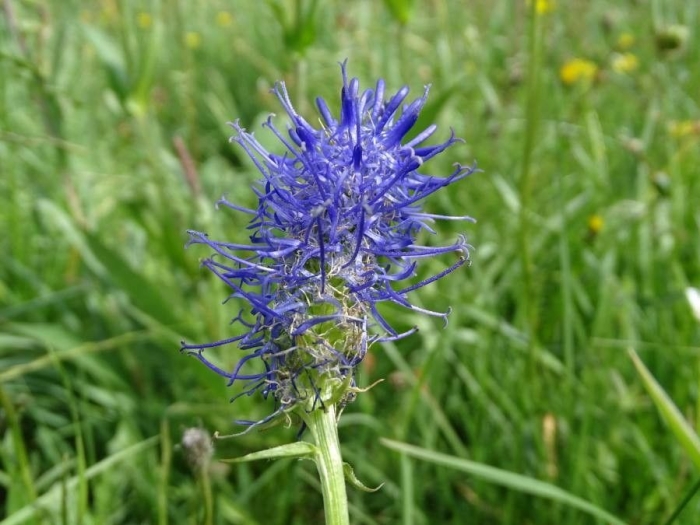Black Rampion
(Phyteuma nigrum)
Black Rampion (Phyteuma nigrum)
/
/

François Combe
CC BY-SA 4.0
Image By:
François Combe
Recorded By:
Copyright:
CC BY-SA 4.0
Copyright Notice:
Photo by: François Combe | License Type: CC BY-SA 4.0 | License URL: https://creativecommons.org/licenses/by-sa/4.0/ | Attribution: François Combe (cc-by-sa) | Rights Holder: François Combe | Publisher: PlantNet | Date Created: 2019-06-18T16:28:59Z | Title: Phyteuma nigrum F.W.Schmidt: flower | Notes: |


















































Estimated Native Range
Summary
Phyteuma nigrum, commonly known as Black Rampion, is a deciduous perennial herb native to a variety of habitats including alpine meadows, grasslands, and light woodlands in Central Europe. It typically grows to a height of 0.3-1 feet (0.09-0.3 meters) and a width of 0.3-0.8 feet (0.09-0.2 meters). Black Rampion forms a basal rosette of leaves with flowering stems bearing spherical inflorescences composed of numerous small flowers that are primarily blue but can also show hints of green and purple. The flowering season is in the summer, and the flowers are moderately showy, attracting pollinators such as bees and butterflies.
Black Rampion is valued for its unique spherical flower heads and is used in rock gardens, alpine collections, and as a border plant in garden settings. It is relatively low-maintenance, requiring only moderate watering and thriving in well-drained soils. It prefers full sun to part shade and benefits from a cool root zone, which can be achieved with mulching. While not commonly afflicted by diseases, it can suffer from root rot if overwatered or planted in poorly drained soils. Black Rampion is not known for being invasive and does not typically present problems when grown outside its native range.CC BY-SA 4.0
Black Rampion is valued for its unique spherical flower heads and is used in rock gardens, alpine collections, and as a border plant in garden settings. It is relatively low-maintenance, requiring only moderate watering and thriving in well-drained soils. It prefers full sun to part shade and benefits from a cool root zone, which can be achieved with mulching. While not commonly afflicted by diseases, it can suffer from root rot if overwatered or planted in poorly drained soils. Black Rampion is not known for being invasive and does not typically present problems when grown outside its native range.CC BY-SA 4.0
Plant Description
- Plant Type: Herb
- Height: 0.3-1.3 feet
- Width: 0.3-0.8 feet
- Growth Rate: Moderate
- Flower Color: Blue, Purple
- Flowering Season: Summer
- Leaf Retention: Deciduous
Growth Requirements
- Sun: Full Sun, Part Shade
- Water: Medium
- Drainage: Medium, Fast
Common Uses
Border Plant, Low Maintenance, Rock Garden
Natural Habitat
Alpine meadows, grasslands, and light woodlands in Central Europe
Other Names
Common Names: Schwarze Teufelskralle, Tummatähkämunkki, Svartvadderot, Blårapunkel, Blå Rapunsel
Scientific Names: , Phyteuma nigrum, Phyteuma spicatum subsp. nigrum, Phyteuma ovatum, Phyteuma nigrum var. coeruleum, Phyteuma spicatum var. caerulescens, Phyteuma nigrum f. longibracteatum, Phyteuma nigrum var. acuminatum, Phyteuma atropurpureum, Phyteuma halleri subsp. nigrum
GBIF Accepted Name: Phyteuma nigrum F.W.Schmidt